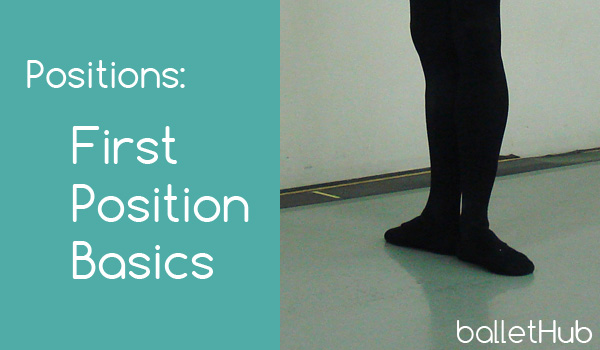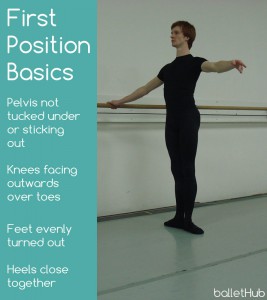First position in ballet is a position where a dancer is typically standing while their feet and legs are turned out and facing away and out from each other. While there is also first position of the arms, today we’ll cover first position with the feet.
While you will likely learn First Position in a beginning ballet class (often your first one) it is widely used throughout ballet technique to accomplish other more advanced steps and relied on everyday by professionals.
First Position in Ballet
There are some basic ideas to start off first with First Position of the feet. These are:
- Your heels are touching, or very close together.
- Your feet and legs are turned out the same, no matter how far that may be.
- Your knees are pointed in the same direction as your toes.
- Your pelvis is not “tucked under” or “sticking out” but instead, straight up and down to allow for correct posture.
And that’s it! Well, of course it can become much more complex than that, but this particular post is for a basic understanding of first position of the legs and feet.
Let’s take a closer look at a great looking first position. For this lesson we have professional ballet dancer Kevin Wilson demonstrating for us. You can find him using all these points explained above to achieve this position.
Things to Avoid with First Position
Many steps require you to be in first position at some point or another, but as you are doing these steps it’s important to remember the things you should be doing but also know why it is important. Let’s take a closer look at the four points above, but why they are important for a proper first position of the feet and legs.
- Some of ballet is purely “just because”. Part of what makes first position a first position is how far the feet are positioned from each other. If there is too much of a gap (anything more than an inch) between your heels then the position will look in between a first and a second position.
- Imagine you are in a dance studio taking a ballet class and facing the mirror. If one foot is pointing straight to the side, but the other to the corner, you will look uneven. What makes a first position clean is that both feet, legs and knees are evenly turned away from each other. Otherwise it’s like you’re facing the wrong direction!
- Whether you are standing, in a plie, or moving through first position, it is always very important that your knees are and remain pointing over your toes. This helps prevent injury and makes sense mechanically. Your knee joint is like a door hinge. Imagine if the hinge was crooked… it would make for a very unstable door! When your foot is planted on the ground and your knee going straight over your toes, you are ensuring you are in a good position to do just about anything including jumps and releves.
- This is very similar to the knee, but more about bad habits. If you are trying to make your first position exactly 180 degrees (meaning your feet are practically making a perfect line straight across) but you do not yet have the strength or flexibility in your hips and legs, you will have to compensate somewhere! Where will this compesation happen? If your knees are over your toes, you are likely tucking back to make this happen, which looks like you are sticking your butt out, or standing like a duck! Don’t stand like a duck, and instead try to keep your pelvis and hips straight up and down. You may not think it is a big deal at first, but when you begin more advanced steps, you will quickly find you lose lots of strength, power and stability with an incorrect posture.


